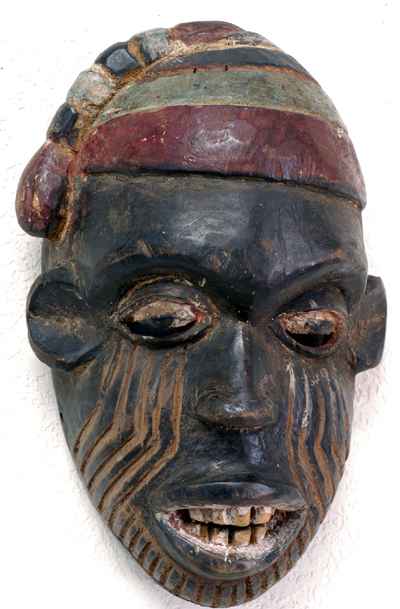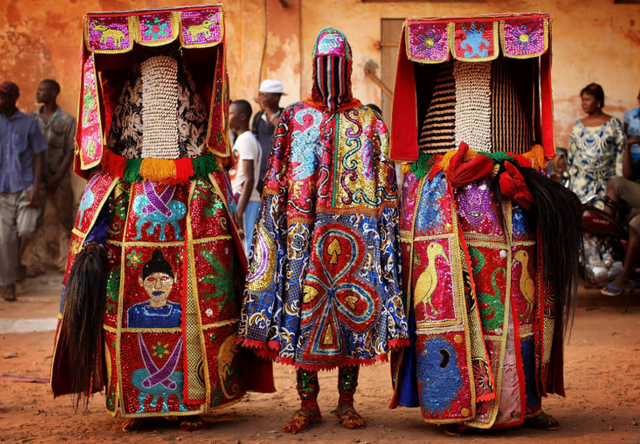Masks and Masquerades
Many African societies have a rich tradition of masquerades, which are plays, ceremonies, or dances by masked performers. Masquerades provide entertainment, define social roles, and communicate religious meaning. The masks used in such performances may be treasured as works of art. They are also important symbols of ancestors, spirits, or even the history and culture of whole peoples.
Masks
Masks take many forms. Some are made of carved wood, such as the towering masks of the Dogon people of Mali. Engraved with designs telling the history of generations, the intricate Dogon creations represent multistory family houses. Other groups make masks from bark, animal skins, plant fibers, and woven cloth. Not all masks are worn on the head or over the face. The traditional rulers of western African states such as Benin wore special masks on their chests or hips that symbolized royalty.

In most societies, only certain people are allowed to own or wear masks. With a few exceptions, women may not wear them. Groups of men—usually members of a community, kinship group, professional organization, or club—own most masks. Masks are also linked with SECRET SOCIETIES. They are symbols of the special knowledge held by those within the society and of their authority. Members of some secret societies wear miniature masks of wood or ivory as badges of membership or symbols of their rank.
Masquerades
Masquerades play a central role in many cultures in western and central Africa. They are less common in northern, eastern, and southern Africa, although they occur among a few groups in these regions. Several BERBER groups in Morocco, for example, hold masquerades in connection with Muslim festivals. The Chewa people of rural Malawi hold ceremonies with individuals wearing spirit masks when a new village headman takes office.
People in many societies believe that spirits become visible and perform through masquerades. Groups such as the YORUBA of Nigeria and the Chokwe of Congo (Kinshasa) hold masquerades in which ancestral spirits appear. The Dan of Ivory Coast and the Ibo of Nigeria believe that the spirits of the forest act out masquerades. Powerful water spirits perform during yearly masquerades in other Nigerian communities.

Important social events, such as INITIATION RITES, or coming-of-age ceremonies, often include masquerades. Spirits acting through masked performers oversee the symbolic rebirth of adolescents into adults. They also may appear in the public ceremonies that present the new adults to the community. Masks also play important roles in funeral customs. Among the Hemba of the Congo region, for example, a figure masked as death appears in two funeral masquerades. The first illustrates the social disorder brought by death; the second shows order restored.
In modern Africa, masquerades are taking on new forms and purposes to meet new needs and conditions. One example is the urban, multiethnic masked associations called Ode-Lay that sprang up in Sierra Leone in the 1950s. Developed in response to social unrest, Ode-Lay associations helped unite people by drawing on the masquerade rituals of various hunting groups and secret societies. In other countries, masquerades have been incorporated into the routines of national dance troupes. Some traditional masquerades, such as Dogon funerals, are occasionally performed for tourists. (See also Art, Dance, Festivals and Carnivals, Music and Song, Mythology.)